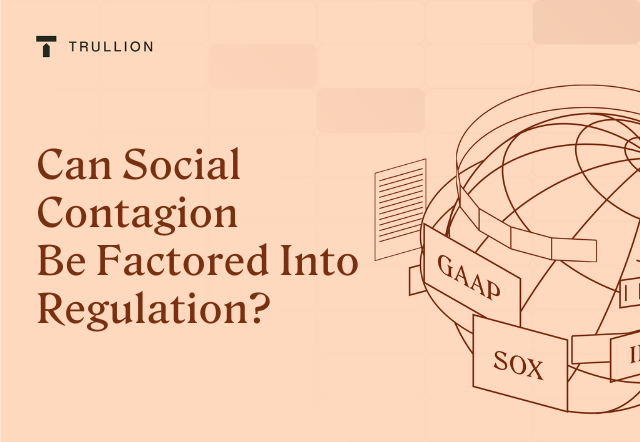The role of social contagion in financial market volatility
Think of social contagion as a process by which information, attitudes, emotions, or behaviors, are rapidly spread throughout a group between members, often without rational thought or reason.
With social media engagement now ubiquitous, social contagion has been able to take hold even more rapidly than in the past, with far-reaching consequences, particularly for financial markets.
Recent seismic events bear this out.
Silicon Valley Bank (SVB) – the 16th-largest bank in the U.S. and home to many well-known technology companies – experienced a catastrophic failure largely driven by social contagion. Despite calls for calm by bank leadership, frenzied social media posts – on Twitter specifically – led to a run on the bank and ultimately its closure and sale.
Gamestop is another example of social media-driven social contagion. In early 2021, the struggling video game retailer experienced a stock frenzy driven by social media. Individual retail investors, primarily organized through the subreddit named ‘r/WallStreetBets’ (WSB), coordinated efforts to buy and hold GameStop stock, challenging hedge funds that had heavily shorted the stock. This social media-fueled movement caused GameStop’s stock price to skyrocket and attracted widespread attention.
GameStop’s volatility sparked debates about market manipulation and the power of individual investors in the digital age. The GameStop saga highlighted the significant influence of social contagion and social media platforms in shaping market dynamics and raised questions about regulation and the democratization of finance.
A third example of modern social contagion is cryptocurrencies. With these specifically, the interconnectedness and viral nature of social media platforms allow information, opinions, and trends to spread rapidly; influencing investor sentiment and driving market movements. Positive or negative sentiments expressed on social media can create waves of enthusiasm – or fear – leading to significant fluctuations in cryptocurrency prices. Moreover, social contagion can lead to herding behaviors in cryptocurrency investments. Herding behavior is of course not new, or unique to crypto – it is the speed and magnitude of influence that is unprecedented.
When influencers, celebrities, or influential figures endorse or promote a particular cryptocurrency on social media, it can result in a surge of interest and investment, sometimes creating speculative bubbles. Conversely, negative news or rumors spread through social media can trigger mass sell-offs and sharp declines in cryptocurrency values.
Clearly, social contagion vis-à-vis financial markets is becoming increasingly problematic.
Risks and consequences of unregulated social contagion
As seen from the examples above, unchecked social contagion in financial markets poses several risks. These include:
Market manipulation: Unscrupulous actors can exploit social contagion to manipulate financial markets. By spreading false information or coordinating efforts to create artificial trends, they can deceive investors and manipulate prices for their own gain. Such manipulation can distort market fundamentals and undermine investor confidence.
Herd mentality: As noted, social contagion can lead to a herd mentality, where individuals imitate the actions of others without conducting proper due diligence. This can result in irrational investment decisions, and increase the risk of sudden market collapses.
Amplification of misinformation: Unregulated social contagion can amplify the spread of misinformation and rumors within financial markets, especially when it comes to social media. False or misleading information can easily gain traction on such platforms and quickly influence investor sentiment. This can result in unwarranted price movements and cause substantial financial losses for individuals who are relying on inaccurate information.
Lack of accountability: On social media today, almost anyone can start a rumor or make a claim, no matter how much truth (or lack of) there is to their post. More often than not, there are few if any consequences for such actions. There is a marked lack of accountability for individuals or groups spreading information or coordinating actions that influence financial markets. This absence of oversight can enable malicious actors to engage in fraudulent activities, such as pump-and-dump schemes, without facing legal repercussions.
Increased volatility: Emotional and impulsive reactions driven by social media trends can lead to rapid and exaggerated price swings. This heightened volatility can create challenges for investors seeking stable and predictable market conditions, increasing the overall risk of financial market participation.
Addressing social contagion risks
To mitigate these risks, regulatory frameworks and oversight are necessary to ensure transparency, fair practices, and accountability in financial markets.
Regulatory measures can play a crucial role in addressing the risks associated with social contagion in financial markets. Here are some potential approaches:
Disclosure and transparency: Regulators can require that social media platforms or financial influencers be required to disclose their affiliations, incentives, or any financial interests related to the information they disseminate.
Market surveillance and enforcement: Regulatory bodies can strengthen their surveillance capabilities to monitor social media platforms and detect potential market manipulation or abusive practices. This can involve leveraging advanced analytics and technology to identify suspicious patterns or coordinated activities. Regulatory authorities could also have the power to enforce penalties and take legal action against those found guilty of manipulating markets or spreading false information.
Oversight of financial influencers: Specific regulations and guidelines can be introduced for financial influencers who have a significant impact on market sentiment, much like the frameworks already in place for accredited journalists. This may involve requiring them to adhere to codes of conduct, disclose their qualifications and potential conflicts of interest, and refrain from engaging in manipulative practices. Regulators should have the authority to enforce compliance and take appropriate action in case of violations.
Collaboration with social media platforms: Regulatory bodies can collaborate with social media platforms to develop guidelines and best practices for responsible information sharing. This can involve establishing mechanisms to report and flag suspicious or misleading content, implementing algorithms or filters to reduce the spread of false information specifically relevant to the financial markets, and promoting the responsible use of social media platforms by financial influencers.
Existing regulatory measures and their limitations
There are multiple regulators and many regulations that are aimed at controlling financial market fluctuations and investor behavior.
For example, in the U.S. there are, among others, the Federal Reserve Board (FRB), the Federal Deposit Insurance Corporation (FDIC), and the Securities and Exchange Commission (SEC).
There are also multiple laws and regulations impacting the financial sector including the Dodd-Frank Wall Street Reform and Consumer Protection Act, which was introduced after the subprime crisis of 2008.
In Europe, there are also several pieces of legislation that attempt to prevent abuse in the financial markets, including Regulation (EU) No 596/2014 on market abuse which seeks to regulate market abuse.
Despite this regulation, gaps continue to exist that allow market abuse. As we’ve seen, social media is a giant hole where regulators are still either too slow or without the correct tools to properly tackle and regulate. Fake accounts for example can be easily set up, may appear to look legitimate, and can make wild claims with zero proof or consequence. AI can be used to back these claims up – a recent mini-storm was created with a fake image circulating of the Pentagon on fire, that sent jitters through the stock market.
On the other hand, overregulating financial markets can potentially stifle innovation by creating barriers, and inhibiting the development of new ideas and products. Excessive regulations can impose burdensome compliance requirements and high entry costs, deterring smaller or emerging players from participating in the market. This can limit competition and hinder the introduction of innovative financial products or services.
Innovation often thrives in an environment that allows for flexibility, creativity, and adaptation, and an overly regulated market can impede the agility and responsiveness required for innovative ideas to flourish. Striking the right balance between regulation and innovation is crucial to fostering a dynamic and resilient financial ecosystem.
Factoring social contagion into future regulation
Social contagion in a world of financial influencers, fake accounts, and social media hysteria is a growing problem.
Part of the answer is in regulating this phenomenon, but this has to be carried out responsibly so as not to completely discourage growth, creativity, and the free functioning of financial markets.
Ideally, regulators should work with as many stakeholders as possible including industry experts, policymakers, technology developers, traditional market participants, social media platforms, financial influencers, and others, to design a system of regulations that protects investors while encouraging financial innovation.
It’s important for regulatory bodies to strike a balance between protecting investors and fostering innovation and market participation – not to mention protecting free speech.
Collaboration between regulators, industry stakeholders, and technology experts is crucial to effectively address the risks of social contagion while ensuring a fair and transparent financial market ecosystem.










